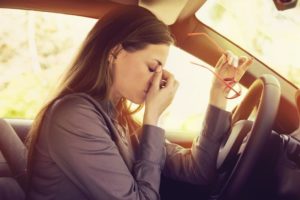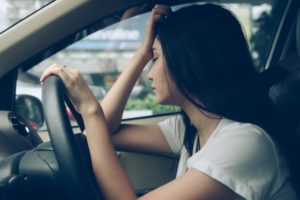Drowsy Driving vs. Drunk Driving: How Similar Are They?
At least 50% of American adults admit to having driven while drowsy, and one in 25 drivers reports having fallen asleep at the wheel in the last month. Drowsy driving is responsible for a significant percentage of road traffic accidents, yet it doesn’t receive nearly as much attention as drunk driving. In recent years, experts have been calling for increased attention to the problem of driving while sleepy or fatigued.
The Stats: Drowsy Driving vs. Drunk Driving
According to reports from the National Highway Traffic Safety Administration (NHTSA) , drowsy driving was responsible for at least 91,000 car crashes, 50,000 injuries, and 795 deaths in 2017. These figures are fairly consistent year-on-year. By contrast, alcohol was thought to be involved in 9,949 fatal crashes in 2017, comprising almost 30% of all fatal crashes.
Alcohol impairment is fairly easy to measure using blood alcohol measurements, but sleep deprivation is tougher to define, especially after the fact. As most people are reluctant to admit they were driving while sleepy, experts believe that drowsy driving accidents are often mistakenly attributed to other factors.
Based on careful analysis, experts believe the real number of annual fatalities due to drowsy driving in the U.S. may be closer to 6,000. This would mean drowsiness is involved in approximately 21% of fatal crashes every year. Between hospital admissions, property damage, and other costs, the estimated societal cost of drowsy driving in the U.S. may be anywhere between $12.5 billion and $109 billion per year .
Why Is It Dangerous To Drive When You Are Tired or Sleep-Deprived?
In addition to the dangers of falling asleep behind the wheel, drowsiness has serious effects on a driver’s attention, judgment, decision-making, coordination, vigilance, and reaction time.
Drowsy drivers may find themselves weaving back and forth between lanes. They may have trouble maintaining the right speed and keeping an appropriate distance from other vehicles , and may be unable to react in time to avoid an obstacle. A significant proportion of drowsy driving accidents involve a single driver driving off the road or into another lane at high speed.
How Does Drowsy Driving Compare To Drunk Driving?
Though not identical , drowsy driving and drunk driving bear some similarities and are considered equally dangerous. Both conditions slow reaction times and affect alertness and decision-making . In controlled studies where researchers were able to measure the amount of sleep deprivation, drunk and drowsy driving both result in a similar amount of crashes.
Alcohol impairment is characterized by problems with eyesight, depth perception, and the ability to judge speed. Drunk drivers are often impulsive, uninhibited, and overly confident, leading to risky driving behaviors. By contrast, fatigue mostly affects our ability to stay vigilant of the road and respond appropriately. It may be particularly dangerous in situations that require fast reflexes to avoid a crash.
After approximately 18 hours of being awake, the effects on reaction time, vigilance, multi-tasking, and hand-eye coordination are comparable to having a blood alcohol content of 0.05% . After 20 hours of being awake, drowsy drivers are impaired on a level equatable to a 0.08% blood alcohol content, which is the current legal limit in most states. After 24 hours awake, impairment is equivalent to a blood alcohol content of 0.1%.
Even mild and short-term sleep deprivation can cause dangerous impairments to driving ability. One study by the AAA Foundation for Traffic Safety found that sleeping between six and seven hours a night doubled the risk of being involved in a crash, while getting less than five hours of sleep doubled it again.

Risk Factors for Drowsy Driving
Drowsy driving is most likely to occur between midnight and 6 am or in the late afternoon, when most people are naturally sleepier. Driving on a monotonous road or driving alone may increase the likelihood of a crash.
Drowsy driving is commonly found in people who have slept less than six hours; those who suffer from sleep apnea or other sleep disorders; young drivers; individuals who have consumed alcohol or who are taking medications; shift workers; and professional drivers.
How To Stay Safe on the Road
The best way to prevent drowsy driving accidents is to get enough sleep. You should also avoid drinking alcohol or taking any medications that could interfere with alertness. While driving, monitor yourself for signs of sleepiness, including:
- Heavy eyelids or frequent blinking
- Yawning
- Daydreaming and trouble focusing
- Poor recall of the last few miles
- Drifting back and forth between lanes
- Hitting rumble strips
- Drooping head
- Tailgating
- Missing signs or exits
- Restlessness, irritability, and aggressiveness
Take regular breaks, and when you notice yourself getting sleepy, pull over and take a 20-minute nap in a safe place. Caffeine, opening the window, and turning up the radio are only short-term fixes and may leave you vulnerable to dangerous “microsleeps.”

Still have questions? Ask our community!
Join our Sleep Care Community — a trusted hub of product specialists, sleep health professionals, and people just like you. Whether you’re searching for the perfect mattress or need expert sleep advice, we’ve got you covered. Get personalized guidance from the experts who know sleep best.
References
13 Sources
-
Drowsy Driving – Sleep and Sleep Disorders. (2017, March 21). Centers for Disease Control and Prevention., Retrieved January 11, 2021, from
https://www.cdc.gov/niosh/work-hour-training-for-nurses/longhours/mod11/02.html -
National High Traffic Safety Administration. (n.d.). Drowsy Driving., Retrieved January 11, 2021, from
https://www.nhtsa.gov/risky-driving/drowsy-driving -
National Highway Traffic Safety Administration. (n.d.-b). FARS Encyclopedia: Crashes – Alcohol. United States Department of Transportation., Retrieved January 11, 2021, from
https://www-fars.nhtsa.dot.gov/Crashes/CrashesAlcohol.aspx -
AAA Foundation for Traffic Safety. (2015, November). Prevalence of Self-Reported Drowsy Driving., Retrieved January 11, 2021, from
https://aaafoundation.org/wp-content/uploads/2017/12/PrevalenceOfSelfReportedDrowsyDrivingReport.pdf -
Asleep at the Wheel—The Road to Addressing Drowsy Driving
https://academic.oup.com/sleep/article/2949300/Asleep -
Shekari Soleimanloo, S., White, M. J., Garcia-Hansen, V., & Smith, S. S. (2017). The effects of sleep loss on young drivers’ performance: A systematic review. PloS one, 12(8), e0184002.
https://pubmed.ncbi.nlm.nih.gov/28859144/ -
Aidman, E., Chadunow, C., Johnson, K., & Reece, J. (2015). Real-time driver drowsiness feedback improves driver alertness and self-reported driving performance. Accident; analysis and prevention, 81, 8–13.
https://linkinghub.elsevier.com/retrieve/pii/S000145751500127X -
Arnedt, J. T., Owens, J., Crouch, M., Stahl, J., & Carskadon, M. A. (2005). Neurobehavioral performance of residents after heavy night call vs after alcohol ingestion. JAMA, 294(9), 1025–1033.
http://jama.jamanetwork.com/article.aspx?doi=10.1001/jama.294.9.1025 -
Zhang, X., Zhao, X., Du, H., & Rong, J. (2014). A study on the effects of fatigue driving and drunk driving on drivers’ physical characteristics. Traffic injury prevention, 15(8), 801–808.
http://www.tandfonline.com/doi/abs/10.1080/15389588.2014.881996 -
American Academy of Sleep Medicine Board of Directors, Watson, N. F., Morgenthaler, T., Chervin, R., Carden, K., Kirsch, D., Kristo, D., Malhotra, R., Martin, J., Ramar, K., Rosen, I., Weaver, T., & Wise, M. (2015). Confronting Drowsy Driving: The American Academy of Sleep Medicine Perspective. Journal of clinical sleep medicine : JCSM : official publication of the American Academy of Sleep Medicine, 11(11), 1335–1336.
https://pubmed.ncbi.nlm.nih.gov/26414989/ -
Williamson, A. M., & Feyer, A. M. (2000). Moderate sleep deprivation produces impairments in cognitive and motor performance equivalent to legally prescribed levels of alcohol intoxication. Occupational and environmental medicine, 57(10), 649–655.
https://pubmed.ncbi.nlm.nih.gov/10984335/ -
Dawson, D., & Reid, K. (1997). Fatigue, alcohol and performance impairment. Nature, 388(6639), 235.
https://www.nature.com/articles/40775 -
Caponecchia, C., & Williamson, A. (2018). Drowsiness and driving performance on commuter trips. Journal of safety research, 66, 179–186.
https://linkinghub.elsevier.com/retrieve/pii/S002243751830001X



